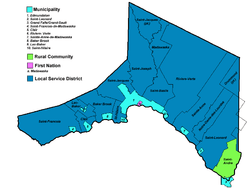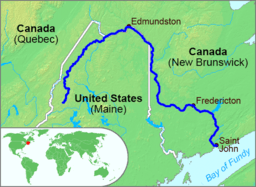Republic of Madawaska
| Republic of Madawaska | ||||||||||||||||||
| Unrecognized state | ||||||||||||||||||
| ||||||||||||||||||
 Municipalities of Madawaska County | ||||||||||||||||||
| Capital | Fort Kent, Maine | |||||||||||||||||
| Languages | English, French | |||||||||||||||||
| Government | Republic | |||||||||||||||||
| Head of State | John Baker | |||||||||||||||||
| History | ||||||||||||||||||
| • | Independence declared | August 10, 1827 | ||||||||||||||||
| • | Arrest of John Baker | September 25, 1827 | ||||||||||||||||
| ||||||||||||||||||
The Republic of Madawaska (French: République du Madawaska) was an unrecognized state in the northwest corner of Madawaska County, New Brunswick (also known as the "New Brunswick Panhandle") and adjacent areas of Aroostook County in the US State of Maine and of Quebec. The word "Madawaska" comes from the Mi'kmaq words madawas (porcupine) and kak (place). Thus, the Madawaska is "the country of the porcupine".[1] The Madawaska River which flows into the Saint John River at Edmundston, New Brunswick and Madawaska, Maine flows through the region.
History
The origins of the unorganized republic lie in the Treaty of Paris (1783), which established the border between the United States of America and the British North American colonies. The Madawaska region remained in dispute until 1842.
In 1817, a US settler, John Baker, arrived in the region. Baker petitioned the state of Maine for inclusion in the state in 1825. On 4 July 1827, Baker and his wife, Sophronia (aka Sophie) Rice, raised a "US" flag sewn by Sophie, on the west of the junction of the Meruimticook (now Baker Brook, after him) and Saint John Rivers. This area is now Baker Brook, New Brunswick.[2]
On August 10 of that year, Baker and others announced their intention to declare the Republic of Madawaska. On that day, the British magistrate confiscated Baker's "American" flag. Baker was arrested by the British on September 25 for conspiracy and sedition. Ultimately, Baker was fined £25 and jailed for two months, or until the fine was paid.[2]
This set off a diplomatic incident, which led to arbitration by the King of the Netherlands. His decision in 1831 was rejected by Maine. After the undeclared Aroostook War (1838–39), the USA and the United Kingdom signed the Webster–Ashburton Treaty on August 9, 1842, finally settling the boundary question. The region was thus annexed to Canada East (now named Quebec) and was transferred to New Brunswick in the 1850s[3]
According to a pamphlet entitled "The Republic of Madawaska" and published at Edmundston, "The myth of the 'Republic of Madawaska' (because it is not a true Republic in a political sense) draws its origins from an answer given to a French official on a tour of inspection during the troubled times by an old Madawaska colonist. Thinking the official a little too inquisitive, he said 'I am a citizen of the Republic of Madawaska' with all the force of an old Roman saying 'I am a citizen of Rome,' and the pride of a Londoner declaring 'I am a British subject.' "
Today's influence
The Republic of Madawaska is still remembered by some locals, who refer to themselves as brayons. A flag of the republic was created in 1938, bearing a bald eagle and an arc of six red stars on a white field. This flag flies at the city hall of Edmundston, New Brunswick, and at Madawaska festivals. The sitting mayor of Edmundston, the largest municipality in the region, also assumes the honorary title of "President of the Republic of Madawaska".
Canadian author Will Ferguson includes a chapter on "The Republic of Madawaska" in Beauty Tips from Moose Jaw: Travels in Search of Canada, his anthology of trans-Canadian vignettes.
 Bicentennial version of the Madawaska Flag, with a porcupine.
Bicentennial version of the Madawaska Flag, with a porcupine. The Saint John River with the New Brunswick-Maine border and the location of Edmundston.
The Saint John River with the New Brunswick-Maine border and the location of Edmundston. The modern Madawaska County in New Brunswick.
The modern Madawaska County in New Brunswick. 1938 version of the Republic of Madawaska flag.
1938 version of the Republic of Madawaska flag. The Republic of Madawaska flag (left), flies along with the Acadian, New Brunswick and Canadian flags in downtown Edmundston, New Brunswick.
The Republic of Madawaska flag (left), flies along with the Acadian, New Brunswick and Canadian flags in downtown Edmundston, New Brunswick.
Notes
- ↑ "Madawaska (Canada–USA) (Canada)", Flags of the World website. Retrieved 13 May 2007
- 1 2 Findlen, George L., "Under His Own Flag: John Baker's Gravestone Memorial in Retrospect", English translation of an article published in Le Revue de la Société historique du Madawaska (French language), issue 30, January/March 2002, 5-55.
- ↑ On the 1850 Mitchell map of Canada-East, it is part of Canada-East; on the 1860 Mitchell map, it is part of New-Brunswick.
External links
- Republic of Madawaska
- The Upper Saint John River Valley history and genealogy
- City of Edmundston